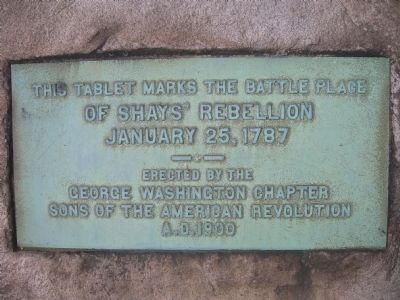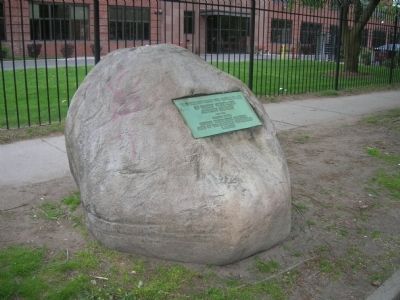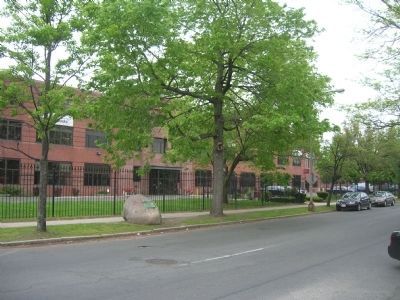Springfield in Hampden County, Massachusetts — The American Northeast (New England)
Shays’ Rebellion
Erected 1900 by George Washington Chapter Sons of the American Revolution.
Topics and series. This historical marker is listed in these topic lists: Agriculture • Notable Events. In addition, it is included in the Sons of the American Revolution (SAR) series list. A significant historical date for this entry is January 25, 1787.
Location. 42° 6.528′ N, 72° 34.541′ W. Marker is in Springfield, Massachusetts, in Hampden County. Marker is on State Street near Federal Street, on the right when traveling west. Touch for map. Marker is at or near this postal address: 1 Federal St, Springfield MA 01105, United States of America. Touch for directions.
Other nearby markers. At least 8 other markers are within walking distance of this marker. Historic Legacy, Shared Future (about 500 feet away, measured in a direct line); Innovation Continues at STCC (about 500 feet away); Forging Arms for Our Nation (about 500 feet away); Springfield Armory (about 700 feet away); To the Memory of George Washington (about 800 feet away); a different marker also named Springfield Armory (about 800 feet away); Gen. Henry Knox Trail (approx. 0.2 miles away); The Military Presence (approx. 0.3 miles away). Touch for a list and map of all markers in Springfield.
More about this marker. The marker is mounted on a large boulder which rests between the sidewalk and State Street, with the marker mounted to be seen from the side faceing the street. The marker and boulder are close to a secure pedestrian gate to the Springfield Technical Community College Technology Park. The site of the marker is a block and a half away from the Springfield Armory, which was goal of the Shays and his rebels.
Regarding Shays’ Rebellion. Daniel Shays (1747?-1825, born Hopkinton, MA), a decorated Revolutionary Army captain, led a rebellion against unsettled economic conditions and against politicians and laws which were grossly unfair to farmers and working people in general. They protested against excessive taxes on property, polling taxes which prevented the poor from voting, unfair actions by the court of common pleas, the high cost of lawsuits, and the lack of a stable currency. They rallied for the government issue of paper money, since at the time there were a variety of paper monies in circulation, but not much was honored at face value.
The Revolutionary War was over, but the United States had yet to form formal government organizations. The Constitutional Congress had yet to convene, and the country was in chaos. The rebels protested against governmental and court systems that were wrought with dictatorial and oppressive regimes and against excessive salaries for government and court officials.
Starting in the Summer of 1786, they closed the courts in Northampton, Great Barrington, Worcester and Concord to prevent the sitting of the courts, whose actions had been grossly unfair to working people.
In January, 1787, Shays and the others insurgents chose the Federal Arsenal in Springfield to be the next target. Shays, with about 1,500 fellow rebels behind him, marched on the arsenal on January 25th, 1787. It was on the grounds of the Springfield Armory that the high-water mark of this violent and wide-spread rebellion, or “Regulation” as it was known at the time, crested in the bloody clash at the arsenal in an effort by the rebels to seize the barracks, cannon, muskets, and ammunition stored there.
The rebel column, of about three regiments, was arrayed on what is today State Street approaching today’s Federal Square before they advanced toward the militia emplaced on the grounds of today’s Armory Square [the grass quadrangle in front of the Springfield Armory NHS Museum]. Militia General William Shepard defended the arsenal with 1,200 local militiamen who, as the rebel column approached, fired their cannons into the ranks of the advancing rebels, killing four and wounding 20. Neither the rebels nor the defending militia fired a musket. Crying "murder" -- for the
insurgent farmer-veterans never supposed their neighbors and fellow veterans would fire on them -- Shays' men retreated in disarray toward Chicopee.
The Supreme Judicial Court soon sentenced fourteen of the rebellion's leaders, including Shays, to death for treason. They were later pardoned by newly-elected Governor John Hancock. Only two men, John Bly and Charles Rose of Berkshire County, were hung for their part in the Rebellion. A newly-elected Massachusetts Legislature in Boston began to undertake the slow work of reform.
Also see . . . Shay's Rebellion & the Making of a Nation. Rich resource for the study of Shay's Rebellion. Inclusive of primary resources, maps and instructive materials. (Submitted on October 1, 2009, by Lynn Kleindienst of Granby, Ma.)
Additional keywords. Springfield Armory Daniel Shays Rebellion 1787
Credits. This page was last revised on September 30, 2020. It was originally submitted on May 18, 2008, by Howard C. Ohlhous of Duanesburg, New York. This page has been viewed 4,074 times since then and 54 times this year. Photos: 1, 2, 3. submitted on May 18, 2008, by Howard C. Ohlhous of Duanesburg, New York. • Kevin W. was the editor who published this page.


